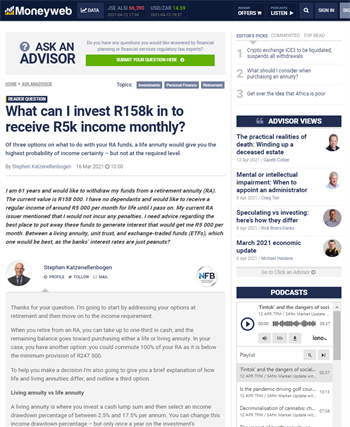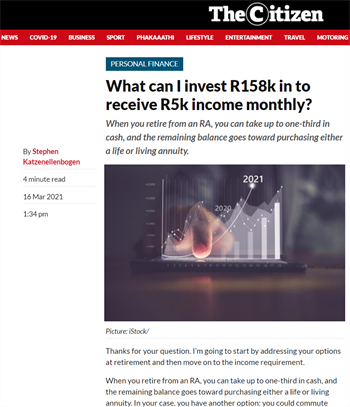Can I get a monthly income of R5 000 after drawing my funds from my RA?
With interest rates as low as they are, what are my alternatives to allocating the cash to a bank savings account?


I am 61 years and would like to withdraw my funds from an RA. The current value is R158 000. I have no dependents and would like to receive a regular income of around R5 000 per month for life until I pass on. My current RA issuer mentioned that I would not incur any penalties. I need advice regarding the best place to put away these funds to generate interest that would get me R5 000 per month. Between a living annuity, unit trust, and ETFs, which one would be best, as the banks' interest rates are just peanuts?
Thanks for your question. I'm going to start by addressing your options at retirement and then move on to the income requirement.
When you retire from an RA, you can take up to 1/3 in cash, and the remaining balance goes toward purchasing either a life or living annuity. In your case, you have another option: you could commute 100% of your RA as it is below the minimum provision of R247 500.
To help you make a decision I’m also going to give you a brief explanation of how life and living annuities differ, and outline a third option.
Living annuity vs life annuity
A living annuity is where you invest a cash lump sum and then select an income drawdown percentage of between 2.5% and 17.5% per annum. You can change this income drawdown percentage – but only once a year on the investment’s anniversary date – giving you the flexibility to draw a higher income if needed. You can choose an income frequency of monthly, bi-annually, quarterly or annually.
A life annuity differs in that it secures you a predetermined monthly income until the day you die. Again, you invest a cash lump sum, and the life insurance company then takes on the obligation to pay you an income for the rest of your life. The payment may be a fixed amount or inflation-linked.
Living annuity
We typically favour a living annuity as it gives the investor the most flexibility in terms of choosing the underlying funds and provides for variable income options.
However, living annuities are most suitable for low-income needs – in relative terms (in other words, income as a percentage of the capital amount).
At R5 000 per month, your income requirement sits at R60 000 annually, which is far above the maximum income level allowed. On the capital amount of R158 000, the maximum annual income drawdown percentage of 17.5% would be R27 650, or roughly R2 300 per month.
Bear in mind that R5 000 per month means you would be drawing approximately 38% of your capital annually.
Even if the selected funds perform well (10% per annum), you will be eroding your capital materially, thereby shortening the investment duration. Therefore, if your income level is not materially adjustable, to say a ±5% drawdown, a living annuity would not be an appropriate option.
To get an income of R5 000 per month (using the 17.5% annual withdrawal limit), you would need to put away a capital amount of R343 000 into the living annuity. And at a 17.5% drawdown rate, your income would drop dramatically as the years go on.
Life annuity
The alternative to a living annuity is a life annuity, in which case you fund the annuity with a lump-sum payment. The issuer then makes regular payments to you for the rest of your life.
However, given the capital amount and the fact that you are only 61 years of age
, the income you would receive from a life annuity will be materially lower than R5 000. On a fixed, single-life annuity, with no guaranteed term and no annual increase, your monthly income (assuming a R158 000 lump-sum investment) would be approximately R1 464 per month until death.
"To get the desired income level of R5 000 per month for the rest of your life, you would need to invest around R523 000 as a lump sum."
RA as a lump sum
A third option could be to commute the entire RA as a lump sum.
Current legislation permits you to withdraw your full RA as a lump sum provided the value is less than R247 500. Therefore, you could withdraw the entire amount (tax-free) and not have to transfer it to an annuity. You can then use the proceeds to supplement your income requirements.
"To reiterate, even with a good return on investment (more than 10% per annum), your income needs of R5 000 per month will erode your capital quickly."
In conclusion
Unfortunately, the product choice cannot solve your high income-requirement relative to your available capital.
Of the three options outlined above, the life annuity gives the highest probability of income certainty, although not at the required level.
In closing, I would like to wish you good luck, and I hope this answer has given you some direction and options regarding your retirement assets.
| This reader question was initially published on Moneyweb and later published online by The Citizen |
|
 |
 |













